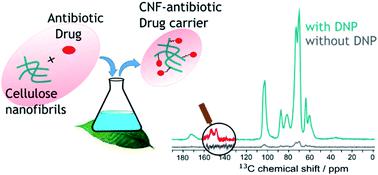当前位置:
X-MOL 学术
›
Chem. Sci.
›
论文详情
Our official English website, www.x-mol.net, welcomes your
feedback! (Note: you will need to create a separate account there.)
The surface chemistry of a nanocellulose drug carrier unravelled by MAS-DNP
Chemical Science ( IF 7.6 ) Pub Date : 2020-03-13 , DOI: 10.1039/c9sc06312a Akshay Kumar 1, 2, 3, 4, 5 , Hippolyte Durand 1, 3, 5, 6, 7 , Elisa Zeno 5, 8, 9 , Cyril Balsollier 1, 3, 5, 9, 10 , Bastien Watbled 1, 3, 5, 9, 11 , Cecile Sillard 1, 3, 5, 6, 7 , Sébastien Fort 1, 3, 5, 9, 10 , Isabelle Baussanne 1, 3, 5, 9, 11 , Naceur Belgacem 1, 3, 5, 6, 7 , Daniel Lee 1, 2, 3, 4, 5 , Sabine Hediger 1, 2, 3, 4, 5 , Martine Demeunynck 1, 3, 5, 9, 11 , Julien Bras 1, 3, 5, 6, 7 , Gaël De Paëpe 1, 2, 3, 4, 5
Chemical Science ( IF 7.6 ) Pub Date : 2020-03-13 , DOI: 10.1039/c9sc06312a Akshay Kumar 1, 2, 3, 4, 5 , Hippolyte Durand 1, 3, 5, 6, 7 , Elisa Zeno 5, 8, 9 , Cyril Balsollier 1, 3, 5, 9, 10 , Bastien Watbled 1, 3, 5, 9, 11 , Cecile Sillard 1, 3, 5, 6, 7 , Sébastien Fort 1, 3, 5, 9, 10 , Isabelle Baussanne 1, 3, 5, 9, 11 , Naceur Belgacem 1, 3, 5, 6, 7 , Daniel Lee 1, 2, 3, 4, 5 , Sabine Hediger 1, 2, 3, 4, 5 , Martine Demeunynck 1, 3, 5, 9, 11 , Julien Bras 1, 3, 5, 6, 7 , Gaël De Paëpe 1, 2, 3, 4, 5
Affiliation

|
Cellulose nanofibrils (CNF) are renewable bio-based materials with high specific area, which makes them ideal candidates for multiple emerging applications including for instance on-demand drug release. However, in-depth chemical and structural characterization of the CNF surface chemistry is still an open challenge, especially for low weight percentage of functionalization. This currently prevents the development of efficient, cost-effective and reproducible green synthetic routes and thus the widespread development of targeted and responsive drug-delivery CNF carriers. We show in this work how we use dynamic nuclear polarization (DNP) to overcome the sensitivity limitation of conventional solid-state NMR and gain insight into the surface chemistry of drug-functionalized TEMPO-oxidized cellulose nanofibrils. The DNP enhanced-NMR data can report unambiguously on the presence of trace amounts of TEMPO moieties and depolymerized cellulosic units in the starting material, as well as coupling agents on the CNFs surface (used in the heterogeneous reaction). This enables a precise estimation of the drug loading while differentiating adsorption from covalent bonding (∼1 wt% in our case) as opposed to other analytical techniques such as elemental analysis and conductometric titration that can neither detect the presence of coupling agents, nor differentiate unambiguously between adsorption and grafting. The approach, which does not rely on the use of 13C/15N enriched compounds, will be key to further develop efficient surface chemistry routes and has direct implication for the development of drug delivery applications both in terms of safety and dosage.
中文翻译:

MAS-DNP揭示的纳米纤维素药物载体的表面化学
纤维素纳米纤维(CNF)是具有高比表面积的可再生生物基材料,这使其成为多种新兴应用(例如按需药物释放)的理想候选者。然而,CNF表面化学的深入化学和结构表征仍然是开放的挑战,特别是对于低重量百分比的官能化而言。当前,这阻止了开发有效,成本效益高且可重复生产的绿色合成路线,从而阻碍了靶向和反应迅速的药物传递CNF载体的广泛开发。我们在这项工作中展示了如何使用动态核极化(DNP)来克服常规固态NMR的灵敏度限制,并深入了解药物功能化的TEMPO氧化纤维素纳米原纤维的表面化学。DNP增强的NMR数据可以清楚地报告起始材料中是否存在痕量的TEMPO部分和解聚的纤维素单元,以及CNFs表面上的偶联剂(用于非均相反应)。与其他分析技术(例如元素分析和电导滴定法)既不能检测偶联剂的存在,也不能明确区分的情况相比,这能够精确估算药物载量,同时将吸附与共价键(在本例中约为1 wt%)区分开来吸附和接枝之间。该方法,不依赖于使用 与其他分析技术(例如元素分析和电导滴定法)既不能检测偶联剂的存在,也不能明确区分的情况相比,这能够精确估算药物载量,同时将吸附与共价键(在本例中约为1 wt%)区分开来在吸附和接枝之间。该方法,不依赖于使用 与其他分析技术(例如元素分析和电导滴定法)既不能检测偶联剂的存在,也不能明确区分的情况相比,这能够精确估算药物载量,同时将吸附与共价键(在本例中约为1 wt%)区分开来吸附和接枝之间。该方法,不依赖于使用富含13 C / 15 N的化合物将是进一步开发有效的表面化学路线的关键,并且就安全性和剂量而言,对药物输送应用的开发具有直接意义。
更新日期:2020-04-24
中文翻译:

MAS-DNP揭示的纳米纤维素药物载体的表面化学
纤维素纳米纤维(CNF)是具有高比表面积的可再生生物基材料,这使其成为多种新兴应用(例如按需药物释放)的理想候选者。然而,CNF表面化学的深入化学和结构表征仍然是开放的挑战,特别是对于低重量百分比的官能化而言。当前,这阻止了开发有效,成本效益高且可重复生产的绿色合成路线,从而阻碍了靶向和反应迅速的药物传递CNF载体的广泛开发。我们在这项工作中展示了如何使用动态核极化(DNP)来克服常规固态NMR的灵敏度限制,并深入了解药物功能化的TEMPO氧化纤维素纳米原纤维的表面化学。DNP增强的NMR数据可以清楚地报告起始材料中是否存在痕量的TEMPO部分和解聚的纤维素单元,以及CNFs表面上的偶联剂(用于非均相反应)。与其他分析技术(例如元素分析和电导滴定法)既不能检测偶联剂的存在,也不能明确区分的情况相比,这能够精确估算药物载量,同时将吸附与共价键(在本例中约为1 wt%)区分开来吸附和接枝之间。该方法,不依赖于使用 与其他分析技术(例如元素分析和电导滴定法)既不能检测偶联剂的存在,也不能明确区分的情况相比,这能够精确估算药物载量,同时将吸附与共价键(在本例中约为1 wt%)区分开来在吸附和接枝之间。该方法,不依赖于使用 与其他分析技术(例如元素分析和电导滴定法)既不能检测偶联剂的存在,也不能明确区分的情况相比,这能够精确估算药物载量,同时将吸附与共价键(在本例中约为1 wt%)区分开来吸附和接枝之间。该方法,不依赖于使用富含13 C / 15 N的化合物将是进一步开发有效的表面化学路线的关键,并且就安全性和剂量而言,对药物输送应用的开发具有直接意义。











































 京公网安备 11010802027423号
京公网安备 11010802027423号